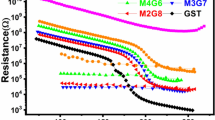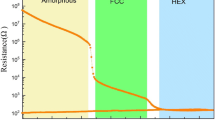Abstract
The inclusion of a Ti inter-adhesion and electrode layer is important for the integration of Ge2Sb2Te5 (GST) phase-change materials into device fabrication. The microstructure and mechanical properties of Ge2Sb2Te5 thin films with a Ti buffer layer (GST/Ti) were investigated in this work. The results showed that the Ti layer affects the microstructure of GST thin films due to the diffusion of Ti atoms into the interface of the GST/Ti stack to form Te2Ti phase. A uniform grain distribution was observed in the GST/Ti thin films. Conversely, a nonuniform distribution and “abnormal” growth of {0001}-oriented grains were observed in GST thin films without a Ti buffer layer. Furthermore, the effect of the Ti transition layer on the grain growth mode of the GST, which has a significant influence on its mechanical properties, is discussed: a smaller unbalanced stress and more uniform grain distribution are evident in GST/Ti, thus the homogeneous grain distribution of GST with the addition of a Ti layer contributes to the higher hardness and elasticity modulus values. The improved mechanical properties of such GST/Ti thin films may be a factor ensuring the robustness of phase-change memory.






Similar content being viewed by others
References
M. Wuttig and N. Yamada, Nat. Mater. 6, 824 (2007).
M. Cassinerio, N. Ciocchini, and D. Ielmini, Adv. Mater. 25, 5975 (2013).
A.M. Mio, S.M. Privitera, V. Bragaglia, F. Arciprete, C. Bongiorno, R. Calarco, and E. Rimini, Nanotechnology 28, 065706 (2017).
V.L. Deringer, R. Dronskowski, and M. Wuttig, Adv. Funct. Mater. 25, 6343 (2015).
A.V. Kolobov, P. Fons, J. Tominaga, and S.R. Ovshinsky, Phys. Rev. B 87, 165206 (2013).
D. Mandelli, S. Caravati, and M. Bernasconi, Phys. Status Solidi B 249, 2140 (2012).
K.N. Chen Jr., C. Cabral, and L. Krusin-Elbaum, Microelectron. Eng. 85, 2346 (2008).
S.G. Alberici, R. Zonca, and P. Pashmakov, Appl. Surf. Sci. 821, 231 (2004).
V.A. Venugopal, G. Ottaviani, C. Bresolin, D. Erbetta, A. Modelli, and E. Varesi, J. Electron. Mater. 38, 2063 (2009).
S.Y. Ie, B.T. Bea, Y.K. Ahn, M.Y. Chang, D.G. You, M.H. Cho, and H. Jeong, Appl. Phys. Lett. 90, 251917 (2007).
M. Behrens, A. Lotnyk, U. Roß, J. Griebel, P. Schumacher, J.W. Gerlach, and B. Rauschenbach, CrystEngComm 20, 3688 (2018).
J. Park and J. Bae, Microscopy 64, 381 (2015).
S. Loubriat, D. Muyard, F. Fillot, A. Roule, M. Veillerot, J.P. Barnes, and S. Maitrejean, Microelectron. Eng. 88, 817 (2011).
J.H. Park, S.W. Kim, J.H. Kim, D.H. Ko, Z. Wu, J.K. Ahn, and S.Y. Choi, Thin Solid Films 612, 135 (2016).
S.M. Jeong, K.H. Kim, S.M. Choi, and H.L. Lee, Jpn. J. Appl. Phys. 48, 045503 (2009).
I.M. Park, J.K. Jung, S.O. Ryu, K.J. Choi, B.G. Yu, Y.B. Park, and Y.C. Joo, Thin Solid Films 517, 848 (2008).
F. Sava, C.N. Borca, A.C. Galca, G. Socol, D. Grolimund, C. Mihai, and A. Velea, Philos. Mag. 99, 55 (2019).
M.A. Caldwell, R.G.D. Jeyasingh, H.S.P. Wong, and D.J. Milliron, Nanoscale 4, 4382 (2012).
J.L. Battaglia, A. Kusiak, A. Saci, R. Fallica, A. Lamperti, and C. Wiemer, Appl. Phys. Lett. 105, 121903 (2014).
J. Narayana and B.C. Larson, J. Appl. Phys. 93, 278 (2003).
L.B. Freund and S. Suresh, Thin Film Materials; Stress, Defect Formation and Surface Evolution (Cambridge: Cambridge University Press, 2004), pp. 71–73.
C.A. Jong, W. Fang, C.M. Lee, and T.S. Chin, Jpn. J. Appl. Phys. 40, 3320 (2001).
Acknowledgements
This work is supported by the National Natural Science Foundation of China (No. 51771023).
Author information
Authors and Affiliations
Corresponding author
Ethics declarations
Conflict of interest
We declare that no conflicts of interest exist.
Additional information
Publisher's Note
Springer Nature remains neutral with regard to jurisdictional claims in published maps and institutional affiliations.
Rights and permissions
About this article
Cite this article
Yin, Q., Chen, L. Use of a Ti Buffer Layer to Improve the Mechanical Properties of Ge2Sb2Te5 Thin Films for Phase-Change Memory. JOM 72, 2146–2153 (2020). https://doi.org/10.1007/s11837-020-04043-5
Received:
Accepted:
Published:
Issue Date:
DOI: https://doi.org/10.1007/s11837-020-04043-5




